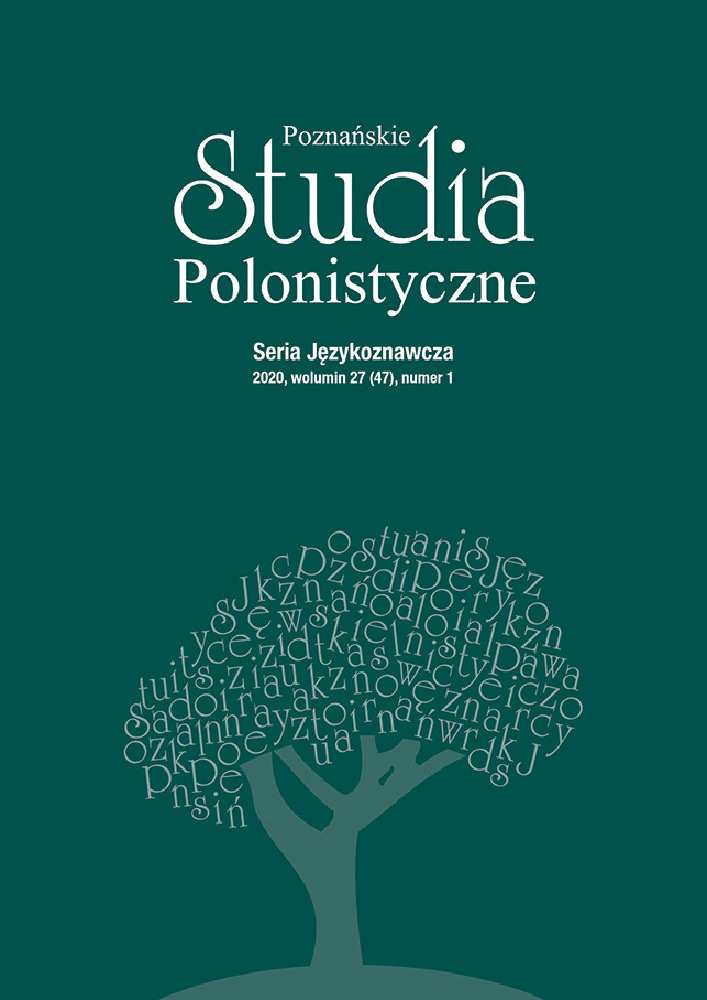Abstract
The article analyses the morphological and syntactic expression of the causator (or cause) in the communicative situations of causation of joy in the Polish language. By causation we mean the semantic category which expresses the causal relationships between the fundamentals of non-linguistic reality. The purpose of this study is to analyse the syntactic structure of communicative situations of causation of joy, on the semantic level of which there are such actants as: agent, experiencer, causator (or cause). All of the analysed constructions were divided into three groups: agentive split constructions, agentive unsplit constructions and non-agentive constructions. Split constructions refer to those in which the agent and causator are separate actants, while unsplit ones refer to those in which these semantic roles are combined into one actant. The results of the study show that the most numerous group among the examples is that of non-agentive constructions.
References
Słowniki
NKJP – Narodowy Korpus Języka Polskiego, http://nkjp.pl [dostęp: 2–20 czerwca 2019].
USJP – Stanisław Dubisz, red., Uniwersalny słownik języka polskiego, t. 1–4, Wydawnictwo Naukowe PWN, Warszawa 2008.
Literatura
Apresyan Valentina (2013), Semantika emotsionalnykh kauzativov: status kauzativnogo komponenta, Kompyuternaya lingvistika i intellektualnye tekhnologii, nr 12 (19), s. 43–57.
Grafova Tatiana i dr. (1991), Chelovecheskiy faktor, Institut yazykoznaniya, izdatelstvo Nauka, Moskva.
Izard Kerrol (2012), Psikhologiya emotsiy, Spb., Piter.
Kuznetsova Elena (2017), K voprosu o sootnoshenii yazykovogo predstavleniya emotsiy i kauzatsii v predlozheniyakh. peredayushchikh emotsionalnoe sostoyaniye v angliyskom yazyke, Tambov, https://tinyurl.com/yaaseybm [dostęp: 2 lipca 2019].
Krasavskiy Nikolay (2010), Kontsept «radost» v russkoy lingvokulture (na materiale slovarnykh statey i assotsiativnogo slovarya), Volgograd, https://tinyurl.com/ybhf8czf [dostęp: 6 marca 2020]
Mikheeva Natalia (2007), Kauzatsiya emotsionalnogo sostoyaniya i emotsionalnogo otnosheniya v ispanskom yazyke, dissertatsiya na soiskaniye uchenoy stepeni kandidata filologicheskikh nauk, Moskva, s. 45–46.
Mikołajczuk Agnieszka (2013), O radości w ujęciu lingwistycznym: z problemów semantycznych badań porównawczych, Lublin, https://tinyurl.com/y7yn47h5[dostęp: 14 marca 2020].
Paducheva Elena (2013), Russkoe otritsatelnoe predlozheniye, Yazyki slavyanskoy kultury. Moskva, s. 61.
Polezhayeva Svetlana (2013), Semantiko-grammaticheskiye osobennosti emotivnykh glagolov, opisyvayushchikh kauzatsiyu subektom emotsionalnogo perezhivaya u sebya samogo i drugogo litsa, Tambov, https://tinyurl.com/ydzxoe9z [dostęp: 6 marca 2020].
Zakusylo Daryna (2018), Predykaty zi znachennyam ‘kauzatsiia radosti’ v polskii movi, Komparatyvni doslidzhennia slovianskykh mov ta literatur, s. 34–42.
Zolotova Galina (1973), Ocherk funktsionalnogo sintaksisa russkogo yazyka, izdatelstvo Nauka. Moskva.
License
Authors
Authors of texts accepted for publication in „Poznańskie Studia Polonistyczne. Seria Językoznawcza” are required to complete, sign and return to the editor's office the Agreement for granting a royalty-free license to works with a commitment to grant a CC sub-license.
Under the agreement, the authors of texts published in „Poznańskie Studia Polonistyczne. Seria Językoznawcza” grant the Adam Mickiewicz University in Poznań a non-exclusive, royalty-free license and authorize the use of Attribution-NoDerivatives 4.0 International (CC BY-ND 4.0) Creative Commons sub-license.
The authors retain the right to continue the free disposal of the work.
Users
Interested Internet users are entitled to use works published in „Poznańskie Studia Polonistyczne. Seria Językoznawcza” since 2016 under the following conditions:
- attribution - obligation to provide, together with the distributed work, information about the authorship, title, source (link to the original work, DOI) and the license itself.
- no derivatives - the work must be preserved in its original form, without the author's consent it is not possible to distribute the modified work, such as translations, publications, etc.
Copyrights are reserved for all texts published before 2016.
Miscellaneous
Adam Mickiewicz University in Poznań retains the right to magazines as a whole (layout, graphic form, title, cover design, logo etc.).
